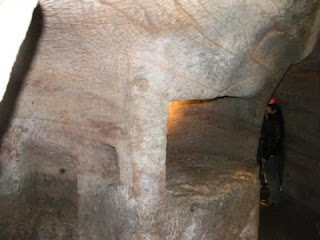Gilmerton is a small village south of Edinburgh. Once a mining area, it is now a suburb of Scotland's capital.
Drum Street is a busy thoroughfare with take-aways and hairdressers, mums with buggies and folk buying filled rolls and a newspaper from the shop on the corner for their lunch break.
A simple
door in an unassuming cottage attached to a bookies didn’t seem worthy of a
second glance. The door was locked and the only information was a poster in the blank
window with a phone number for the “ Gilmerton Cove". A quick call on the mobile and a cheery voice said,
“ I’ll just be a minute, we’re just coming up
from the underground “
A minute later a smiling young woman appeared and welcomed us in. The entrance room was
small and hung with information panels
about the Cove.
Despite the
fanciful interpretations and puns on covens and covenanters, it would seem that
“cove” is just and old Scots word for cave.
A cave
indeed as we discovered when, hard-hatted for health and safety reasons, we were
led down in the depths below the pavement level.
The Tunnels are low!
The hard hats proved that, for once, health’n’safety
rulings can be useful as the tunnels are quite low and the sandstone though soft and easily
worked, is not so soft as allow head butting with impunity.
Used by a local blacksmith, George Paterson as
a store, home and illegal drinking bothy in the eighteenth century, the Cove has been connected fancifully with
Freemasonry ( there are a couple of Masonic symbols carved as graffiti),
Covenanters, witches, Robert the Bruce,
he of the cave and the spider, and, of course, the Knights Templar.
The
blacksmith claimed he had hewn the multi-chambered construction himself in five
years which was manifestly nonsense. He may have rediscovered it and even worked
some of the sandstone into which it has been cut but this is not the work of a
single eighteenth century blacksmith.
Archaeological opinion is that it is much
older, the pock marked walls of the tunnels being evidence of older tools than
iron chisels.
The marks of simple tools on the walls
Some of the features have attracted simplified explanations and names to fit with the preconceived and probably erroneous notions of the functions of the"cove".
The misnamed “forge” and “well” are not what
they seem at first sight. The
“punchbowl” is obviously not that either.
Why bother to carve a bowl into solid stone when it is an easily
portable piece of table ware and what use is a forge in a chamber with no chimney?
The table room wth carved "punchbowl"
Despite all
the romantic stories and tales of tunnels extending for miles to Craigmillar Castle and Roslin Chapel, I got the
distinct impression that whatever use it had been put in the recent past, this
place was much, much older.
It must have taken a great deal of social organisation and possibly coercion to dig out all this solid sandstone and to fashion the features within the chambers. Only a group with a powerful grip on a community could command such obedience and effort, especially in times when providing the day to day neccessities of life was hard enough. In return for all this effort what did the people get? Solace, the allaying of fears, comfort in bereavement, the promise of good harvests, predictions and prophesies - all the trappings of a religion of some kind.
It must have taken a great deal of social organisation and possibly coercion to dig out all this solid sandstone and to fashion the features within the chambers. Only a group with a powerful grip on a community could command such obedience and effort, especially in times when providing the day to day neccessities of life was hard enough. In return for all this effort what did the people get? Solace, the allaying of fears, comfort in bereavement, the promise of good harvests, predictions and prophesies - all the trappings of a religion of some kind.
The Hypogeum
in Malta is over 4000 years old dating from the time when the Chalcolithic, the
copper age, was at its height and fertility
rites and Earth Mother religion seemed to have predominated among the
early agriculturalist peoples.
An oracle window?
Though much more sophisticated and complex than
Gilmerton Cove, there are many striking similarities. Niches for cult objects, windows cut in to
chambers that may have been where oracles were consulted, altars, votive pits -
all have echoes at Gilmerton.
The mis-named forge, possibly place for a cult object
Both at the
Hypogeum and at the associated megalithic temples at Tarxien, “fat lady” statues and votive offerings suggestive of
mother goddess have been found. Where
better to worship such a goddess then in the body of the goddess herself ,
under the ground.
A model of the fat lady statue from the megalithic site im Malta
The Hypogeum is a World Heritage Site and,
while Gilmerton Cove isn’t in that league, it deserves a visit, a fascinating
place that hopefully will be preserved, explored and subjected to academic
scrutiny in the years to come.






No comments:
Post a Comment